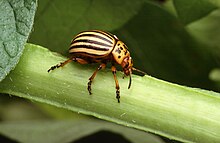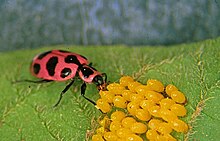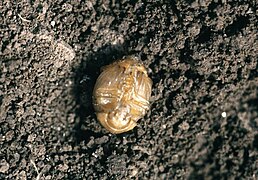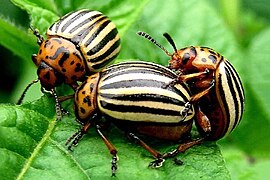
A | B | C | D | E | F | G | H | CH | I | J | K | L | M | N | O | P | Q | R | S | T | U | V | W | X | Y | Z | 0 | 1 | 2 | 3 | 4 | 5 | 6 | 7 | 8 | 9
| Colorado potato beetle | |
|---|---|

| |
| Scientific classification | |
| Domain: | Eukaryota |
| Kingdom: | Animalia |
| Phylum: | Arthropoda |
| Class: | Insecta |
| Order: | Coleoptera |
| Family: | Chrysomelidae |
| Genus: | Leptinotarsa |
| Species: | L. decemlineata
|
| Binomial name | |
| Leptinotarsa decemlineata | |
| Synonyms[2] | |
| |
The Colorado potato beetle (Leptinotarsa decemlineata; also known as the Colorado beetle, the ten-striped spearman, the ten-lined potato beetle, and the potato bug) is a beetle known for being a major pest of potato crops. It is about 10 mm (3⁄8 in) long, with a bright yellow/orange body and five bold brown stripes along the length of each of its elytra. Native to the Rocky Mountains, it spread rapidly in potato crops across America and then Europe from 1859 onwards.[3]
The Colorado potato beetle was first observed in 1811 by Thomas Nuttall and was formally described in 1824 by American entomologist Thomas Say.[3] The beetles were collected in the Rocky Mountains, where they were feeding on the buffalo bur, Solanum rostratum.[4]
Description
Adult beetles typically are 6–11 mm (0.24–0.43 in) in length and 3 mm (0.12 in) in width. They weigh 50–170 mg.[5] The beetles are orange-yellow in color with 10 characteristic black stripes on their front wings or elytra. The specific name decemlineata, meaning "ten-lined", derives from this feature.[4][6]
Adult beetles may be visually confused with L. juncta, which is the false potato beetle. Unlike the Colorado potato beetle, it is not an agricultural pest. L. juncta also has alternating black and white strips on its back, but one of the white strips in the center of each wing cover is missing and replaced by a light brown strip.[7]
Larvae
The orange-pink larvae have a large, 9-segmented abdomen, black head, and prominent spiracles, and may measure up to 15 mm (0.59 in) in length in their final instar stage.
The beetle larva has four instar stages. The head remains black throughout these stages, but the pronotum changes colour from black in first- and second-instar larvae to having an orange-brown edge in its third-instar. In fourth-instar larvae, about half the pronotum is coloured light brown.[4][8] This tribe is characterised within the subfamily by round to oval-shaped convex bodies, which are usually brightly coloured, simple claws which separate at the base, open cavities behind the procoxae, and a variable apical segment of the maxillary palp.[9][6]
Distribution
The beetle is most likely native to the area between Colorado and northern Mexico, and was discovered in 1824 by Thomas Say in the Rocky Mountains. It is found in North America, and is present in every state and province except Alaska, California, Hawaii, and Nevada.[4] It now has a wide distribution across Europe and Asia, totaling over 16 million km2.[10][11]
Its first association with the potato plant (Solanum tuberosum) was not made until about 1859, when it began destroying potato crops in the region of Omaha, Nebraska. Its spread eastward was rapid, at an average distance of 140 km per year.[12] The beetle has the potential to spread to temperate areas of East Asia, India, South America, Africa, New Zealand, and Australia.[13]
Human interaction
By 1874 it had reached the Atlantic Coast.[4] From 1871, American entomologist Charles Valentine Riley warned Europeans about the potential for an accidental infestation caused by the transportation of the beetle from America.[12] From 1875, several Western European countries, including Germany, Belgium, France, and Switzerland, banned imports of American potatoes to avoid infestation by L. decemlineata.[14]
These controls proved ineffective, as the beetle soon reached Europe. In 1877, L. decemlineata reached the United Kingdom and was first recorded from Liverpool docks, but it did not become established. Many further outbreaks have occurred; the species has been eradicated in the UK at least 163 times. The last major outbreak was in 1976. It remains as a notifiable quarantine pest in the United Kingdom and is monitored by DEFRA to prevent it from becoming established.[15] A cost-benefit analysis from 1981 suggested that the cost of the measures used to exclude L. decemlineata from the UK was less than the likely costs of control if it became established.[16]
Elsewhere in Europe, the beetle became established near USA military bases in Bordeaux during or immediately following World War I and had proceeded to spread by the beginning of World War II to Belgium, the Netherlands, and Spain. The population increased dramatically during and immediately following World War II and spread eastward, and the beetle is now found over much of the continent. After World War II, in the Soviet occupation zone of Germany, almost half of all potato fields were infested by the beetle by 1950. In East Germany, they were known as Amikäfer ('Yankee beetles') following a governmental claim that the beetles were dropped by American planes. In the European Union, it remains a regulated (quarantine) pest for the Republic of Ireland, Balearic Islands, Cyprus, Malta, and southern parts of Sweden and Finland. It is not established in any of these member states, but occasional infestations can occur when, for example, wind blows adults from Russia to Finland.[17][18]
-
Native range of the potato and native and current range of the Colorado beetle
-
Expansion of the Colorado potato beetle's range in North America, 1859–1876
-
Expansion of the Colorado potato beetle's range in Europe, 1921–1964
Lifecycle
Colorado potato beetle females are very prolific and are capable of laying over 500 eggs in a 4- to 5-week period.[19] The eggs are yellow to orange, and are about 1 mm (0.039 in) long. They are usually deposited in batches of about 30 eggs on the underside of host leaves. Development of all life stages depends on temperature.
After 4–15 days, the eggs hatch into reddish-brown larvae with humped backs and two rows of dark brown spots, one row on each side. They feed on the leaves of their host plants. Larvae progress through four distinct growth stages (instars). First instars measure about 1.50 mm (0.059 in) long, and the last (fourth) instars about 8 mm (0.31 in) long. The first through third instars each last about 2–3 days; the fourth lasts 4–7 days.
Upon reaching full size, each fourth instar spends several days as a nonfeeding prepupa, which can be recognized by its inactivity and lighter coloration. The prepupae drop to the soil and burrow to a depth of several inches, then pupate.[4] In 5 to 10 days, the adult beetle emerges to feed and mate. This beetle can thus go from egg to adult in as little as 21 days.[19] Depending on temperature, light conditions, and host quality, the adults may enter diapause and delay emergence until spring. They then return to their host plants to mate and feed; overwintering adults may begin mating within 24 hours of spring emergence.[20] In some locations, three or more generations may occur each growing season.[4]
-
Eggs laid on the underside of a leaf
-
1st instar larva after hatching
-
3rd instar stage of larvae
-
4th instar stage of larva, before pupation
-
Pupa
-
Adult beetle after emergence
-
Mating adult beetles
Mate and host searching
Visual cues are important for Colorado potato beetles during the mate and host search. In a study done by Szentsi, Weber, and Jermy in the paper Role of visual stimuli in host and mate location of the Colorado potato beetle, the beetles' attraction to boards with different spectral bands, reaction to beetle-sized stationary objects, responses to such objects on boards, and attraction to prior female substances were investigated.[21] The researchers' hypothesis was that experience with female substances would cause behavior changes in males.[21] When shown colored boards, the beetles had a positive response between 45° and 0° in terms of mean angular directions (MADs).[21] Beads and dead beetles without boards evoked a weaker response with MADs being variable. Colored boards and bead combinations displayed more positive MADs responses between 45° and 0°.[21] Experience with female substances showed that male beetles showed high responses to female scent. According to the study, 43 of the 49 runs where female smear was used had a response score of 5 in contrast to the 23/42 runs without female smear receiving a score of 5.[21]
Colorado potato beetles are also attracted to the volatiles potato plants emit.[22] In the article Sexual contact influences orientation to plant attractant in Colorado potato beetle, Leptinotarsa decemlineata Say (Coleoptera: Chrysomelidae) by Joseph Dickens, the beetles were attracted to kairomone substance but after mating, their attraction to it reduced. Within 24 hours of mating, there was no difference between levels of attraction to kairomone and control solvent.[22] Lack of attraction occurred for two days but resumed three days after mating. Male beetles produce a pheromone that is further enhanced by plant host volatiles like the kairomone. After a beetle is attracted to the host, mating occurs and the female lays her eggs on the plant.[22] The beetles' attraction to kairomone decreases until 72 hours later once oviposition occurs and the probability of re-mating increases.[22]
Behavior and ecology
Diet
L. decemlineata has a strong association with plants in the family Solanaceae, particularly those of the genus Solanum. It is directly associated with Solanum cornutum (buffalo-bur), Solanum nigrum (black nightshade), Solanum melongena (eggplant or aubergine), Solanum dulcamara (bittersweet nightshade), Solanum luteum (hairy nightshade), Solanum tuberosum (potato), and Solanum elaeagnifolium (silverleaf nightshade). They are also associated with other plants in this family, namely the species Solanum lycopersicum (tomato) and the genus Capsicum (pepper).[23]
Enemies

At least 13 insect genera, three spider families, one phalangid (Opiliones), and one mite have been recorded as either generalist or specialized predators of the varying stages of L. decemlineata. These include the ground beetle Lebia grandis, the coccinellid beetles Coleomegilla maculata and Hippodamia convergens, the shield bugs Perillus bioculatus and Podisus maculiventris, various species of the lacewing genus Chrysopa, the wasp genus Polistes, and the damsel bug genus Nabis.[24]
The predatory ground beetle L. grandis is a predator of both the eggs and larvae of L. decemlineata, and its larvae are parasitoids of the pupae. An adult L. grandis may consume up to 23 eggs or 3.3 larvae in a single day.[25]
In a laboratory experiment, Podisus maculiventris was used as a predatory threat to female L. decemlineata specimens, resulting in the production of unviable trophic eggs alongside viable ones; this response to a predator ensured that additional food was available for newly hatched offspring to increase their survival rate. The same experiment also demonstrated the cannibalism of unhatched eggs by newly hatched L. decemlineata larvae as an antipredator response.[26]










